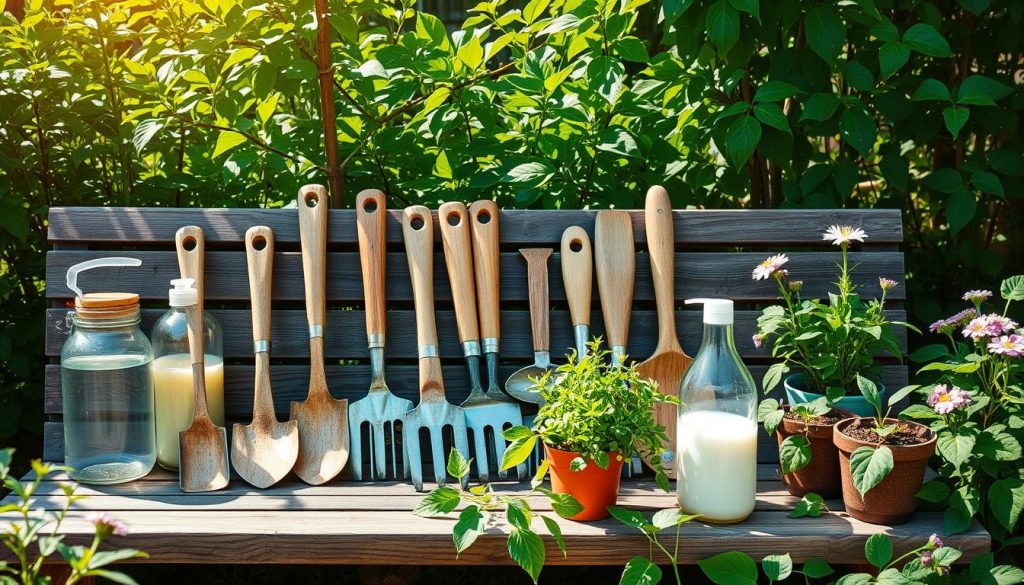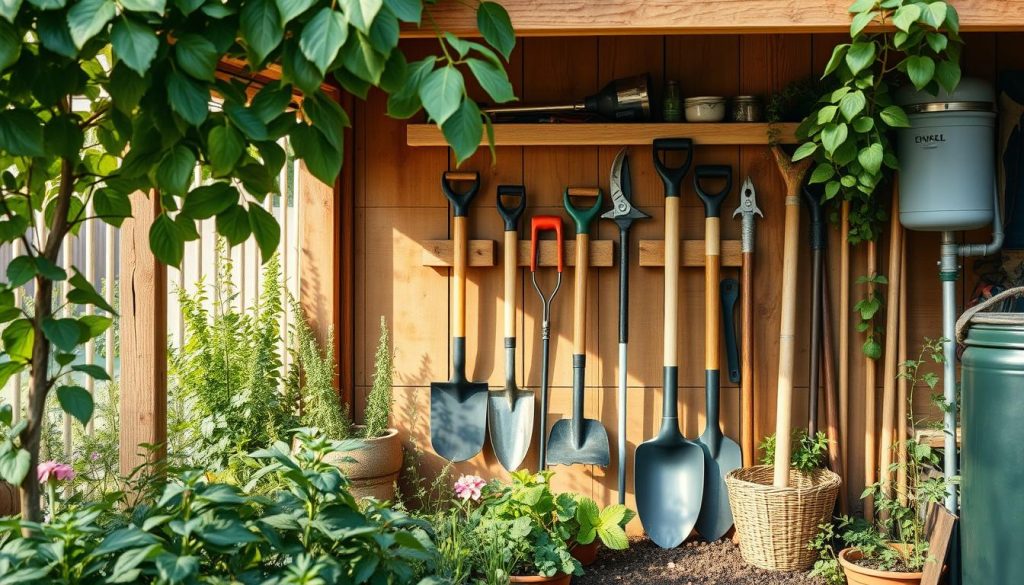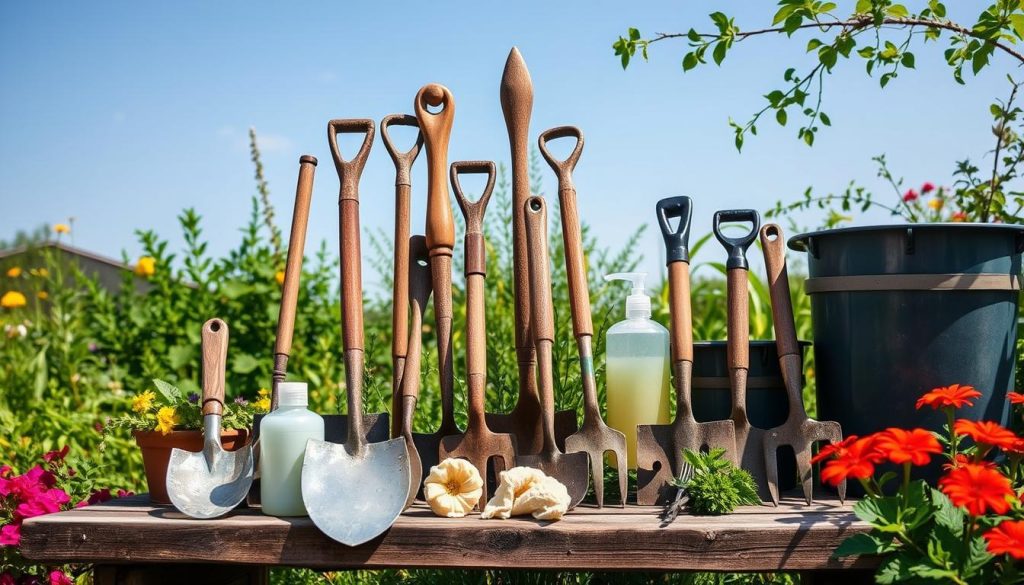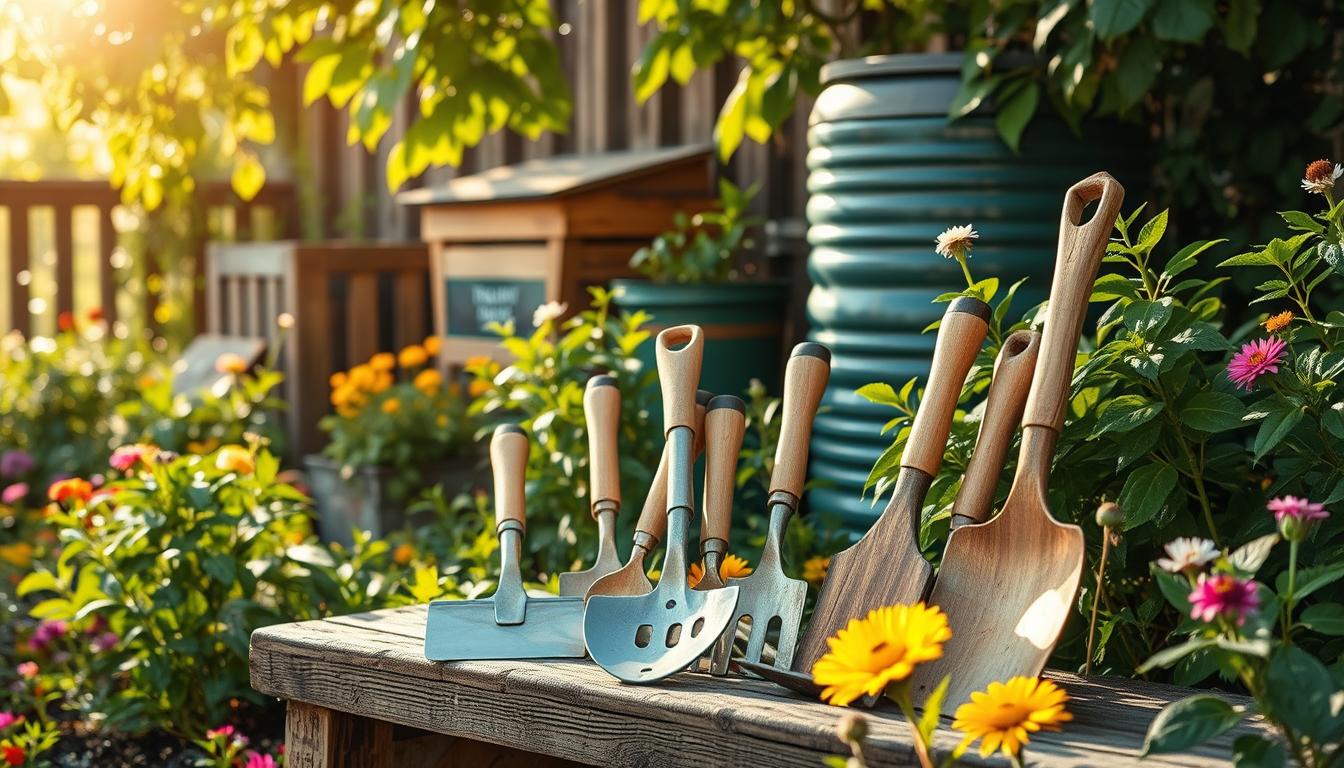As a gardener, I know how vital it is to care for my tools in a way that’s good for the planet. This means using methods and materials that are kind to the environment. It also helps my tools last longer and work better.
Learning to care for gardening tools in a sustainable way is key. It starts with using eco-friendly practices. This approach helps me keep my tools in top condition.
By following these eco-friendly practices, I can ensure my gardening tools stay in great shape. I’m excited to share my tips and tricks with you. We’ll cover cleaning, storing, recycling, and upcycling. All while focusing on sustainable gardening tool maintenance.
Why Sustainable Maintenance Matters
As a gardener, I’ve learned that taking care of my tools is just as important as tending to my plants. Sustainable garden tool maintenance is key. It helps extend my tools’ life, cuts down on waste, and saves money. By using green gardening tool upkeep, my tools stay in top shape. They work better, helping me reach my gardening goals.
Some of the benefits of sustainable maintenance include:
- Reduced environmental impact: Proper tool care means I don’t need to replace them as often. This cuts down on waste and lowers my carbon footprint.
- Cost savings: Regular upkeep makes my tools last longer. This means I spend less on new tools and repairs.
- Improved performance: Tools in good condition work better. This makes gardening easier and more efficient.
By focusing on sustainable garden tool maintenance and green gardening tool upkeep, I make my gardening more sustainable and efficient. It benefits both my garden and the environment.
My Favorite Eco-Friendly Cleaning Methods
As a gardener, I’ve found that cleaning tools is key to keeping them in good shape. But, it can also harm the environment. That’s why I’m excited to share my favorite ways to clean tools without harming the planet. These methods include using natural ingredients and reusable materials.
For eco-friendly tool care, start with simple items like baking soda, vinegar, and lemon juice. These can make effective cleaners that are kind to both tools and the environment. For instance, baking soda and water can clean off dirt. Vinegar and water can help remove rust.

Using reusable materials is also a great idea. Items like cloths and brushes can be washed and used many times. This cuts down on waste from disposable products. By using these methods, we can help the environment and keep our tools in top shape.
Natural Recipes for Cleaning Solutions
- Mix baking soda and water to create a paste for scrubbing away dirt and grime
- Combine vinegar and water to create a solution for removing rust and corrosion
- Use lemon juice and water to create a natural disinfectant for tools
Reusable Materials for Tool Care
Some examples of reusable materials for tool care include:
- Cloths made from natural fibers like cotton or hemp
- Brushes with synthetic or natural bristles
- Microfiber cloths for cleaning and polishing tools
Choosing Sustainable Materials for Tools
As a gardener, I’ve learned that picking the right materials for tools is key. Sustainable practices for garden tool care help reduce our environmental impact. When choosing gardening tools, we often think about performance and price. But, sustainability is also very important.
Keeping tools sustainable is good for the environment and makes them last longer. By choosing sustainable materials, we cut down on waste. We also support companies that care about the planet. Some brands now make tools from recycled materials like recycled steel or sustainable wood.
Brands That Prioritize Sustainability
- Fiskars: Known for their high-quality gardening tools, Fiskars also prioritizes sustainability in their manufacturing processes.
- Burpee: This seed company also offers a range of gardening tools made from sustainable materials.
- GreenWorks: This brand offers a range of eco-friendly gardening tools, including solar-powered and battery-powered options.
How to Identify Eco-Friendly Tools
When shopping for gardening tools, look for products made from sustainable materials. Check if the company uses eco-friendly practices in making their tools. By choosing sustainable tools, we help the environment and support companies that care about it.
Proper Storage Techniques
To keep our gardening tools in good shape, we need to store them right. We should have a special place for our tools. This spot should be clean, dry, and organized. This way, we avoid damage and make our tools last longer.
It’s important to have a place for each tool. This makes it easier to find what we need. We can use sheds, cabinets, and hooks to protect our tools from the weather. These can be made from materials like reclaimed wood or recycled plastic.

- Storing tools in a dry, well-ventilated area to prevent rust and corrosion
- Using tool racks or pegboards to keep tools organized and within reach
- Labeling storage containers to easily identify what’s inside
By following these tips, we can keep our tools in top shape. This is key to maintaining gardening tools sustainably.
Routine Maintenance for Longevity
To keep our gardening tools in top shape, we need to maintain them regularly. Eco-friendly gardening tool care is key to this. It helps our tools last longer. Regular checks and care prevent big problems.
Checking our tools often is vital. It lets us spot wear and tear early. This way, we can fix issues before they get worse. It also means we don’t have to replace tools as often.
Regular Inspection and Upkeep
Here are some tips for regular checks and care:
- Check tools for signs of rust or corrosion
- Inspect handles for damage or wear
- Clean tools regularly to prevent dirt and debris buildup
Sharpening tools is also crucial. It keeps them sharp and effective. This is good for the environment because it means we don’t need to replace tools as often.
Sharpening Tools the Right Way
By following these tips, we can keep our tools in excellent condition. Remember, taking care of our tools is all about being proactive. It helps them last longer and work better.
Recycling and Upcycling Old Tools
As I look for ways to care for my gardening tools, I’ve learned about the need for eco-friendly practices. When our tools no longer work, we should dispose of them in a way that’s good for the planet. Donating them to local charities or gardening groups is a great option. This way, they can be fixed and used again.
Here are some eco-friendly ways to maintain your gardening tools:
- Donate gently used tools to local schools or community gardens
- Participate in tool swap events or online forums to exchange tools with other gardeners
- Repurpose old tools as plant markers, garden decorations, or other creative items
By following these tips, we can help reduce waste and support sustainable gardening. Recycling and upcycling old tools also opens up new creative possibilities. 
Donating Tools You No Longer Use
Donating tools is a wonderful way to help them last longer and support local gardening projects. Many groups take in used tools to give to those who need them. This not only cuts down on waste but also brings gardeners together.
Creative Upcycling Ideas
Upcycling old tools is a fun and creative way to give them a new life. You could turn an old rake into a garden trellis or use an old watering can as a planter. With a bit of imagination, we can make old tools into unique and useful items for our gardens.
The Role of Community in Sustainable Gardening
Sustainable gardening is more than just doing things on our own. It’s about creating a community that shares knowledge and resources. By joining local gardening groups and workshops, we can learn from each other. We can also share our skills in keeping gardening tools in good shape.
Here are some ways to get involved in the community:
- Joining local gardening clubs or organizations
- Participating in online forums or social media groups
- Attending workshops or seminars on sustainable gardening practices
Local Gardening Groups and Workshops
Local gardening groups and workshops are great for meeting people who think like us. They offer hands-on training, lectures, and discussions on sustainable gardening. It’s a chance to learn and share ideas.
Sharing Tools with Neighbors
Sharing tools with neighbors is a way to build community and support sustainable gardening. It helps us save money and reduce waste. It also brings us together, encouraging us to work together.
My Gardening Tool Checklist
Reflecting on my gardening tool care, I’ve made a detailed checklist. It helps me have all I need for a green gardening journey. The list focuses onessential tools for sustainable gardening. These are sturdy, long-lasting tools like pruners, trowels, and rakes from recycled materials.
I also ensure I have good cleaning supplies. This includes natural soap and reusable rags to keep tools clean.
Essential Tools for Sustainable Gardening
My top picks for sustainable gardening tools are:
– Pruners: Fiskars Recycled Gear Pruners
– Trowel: Radius Garden 100% Recycled Aluminum Trowel
– Rake: Lee Valley Stainless Steel Garden Rake
– Cleaning Rags: Reusable microfiber cloths
– Natural Cleaning Solution: Homemade vinegar and baking soda mix
Keeping Track of Maintenance Routines
Tokeep track of my maintenance routines, I use a simple log. It records when I clean, sharpen, and check each tool. This keeps my gardening gear in top shape and extends its life.
By following this checklist and caring for my tools, I can enjoy a healthy, eco-friendly garden for years.

